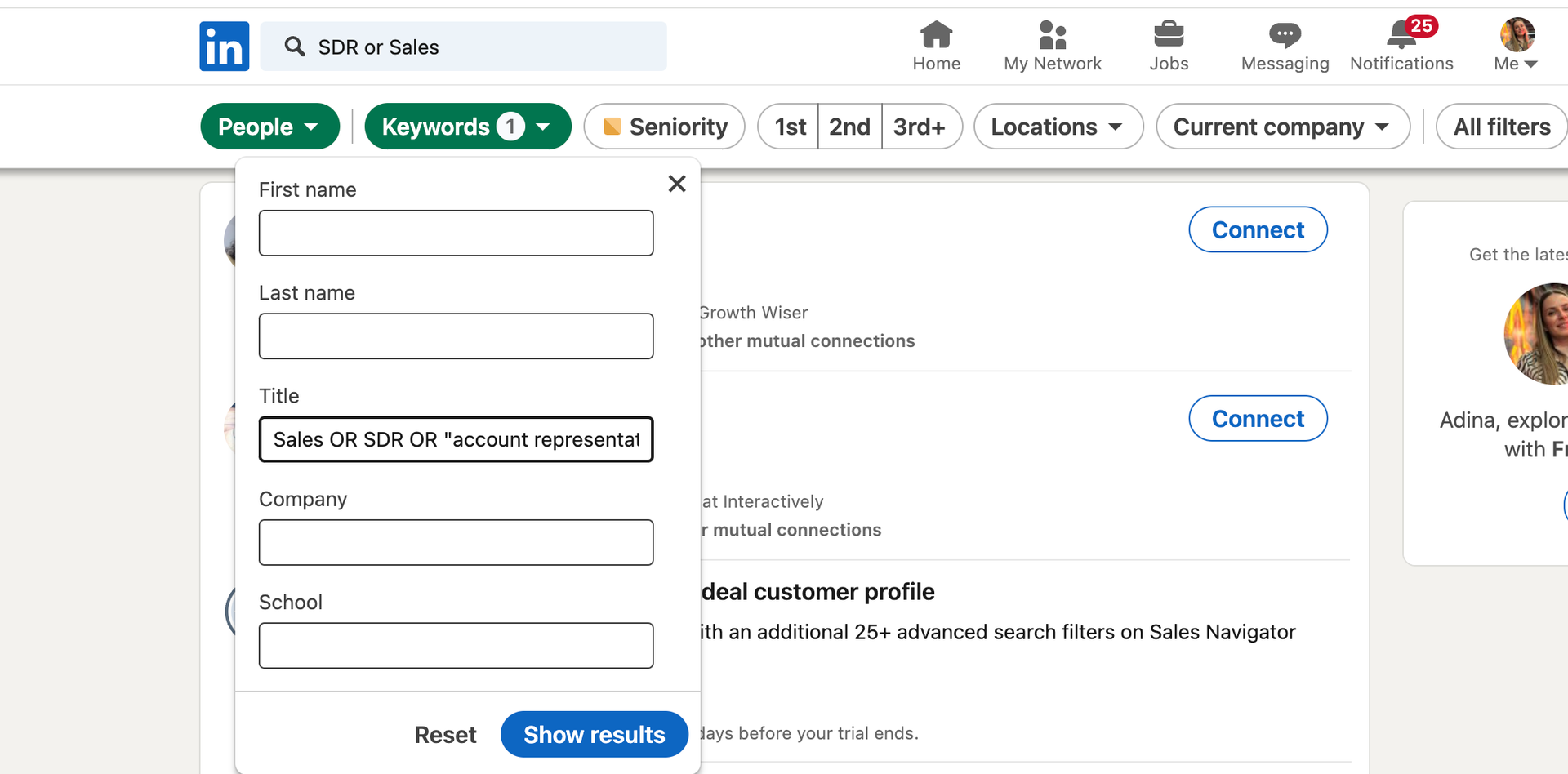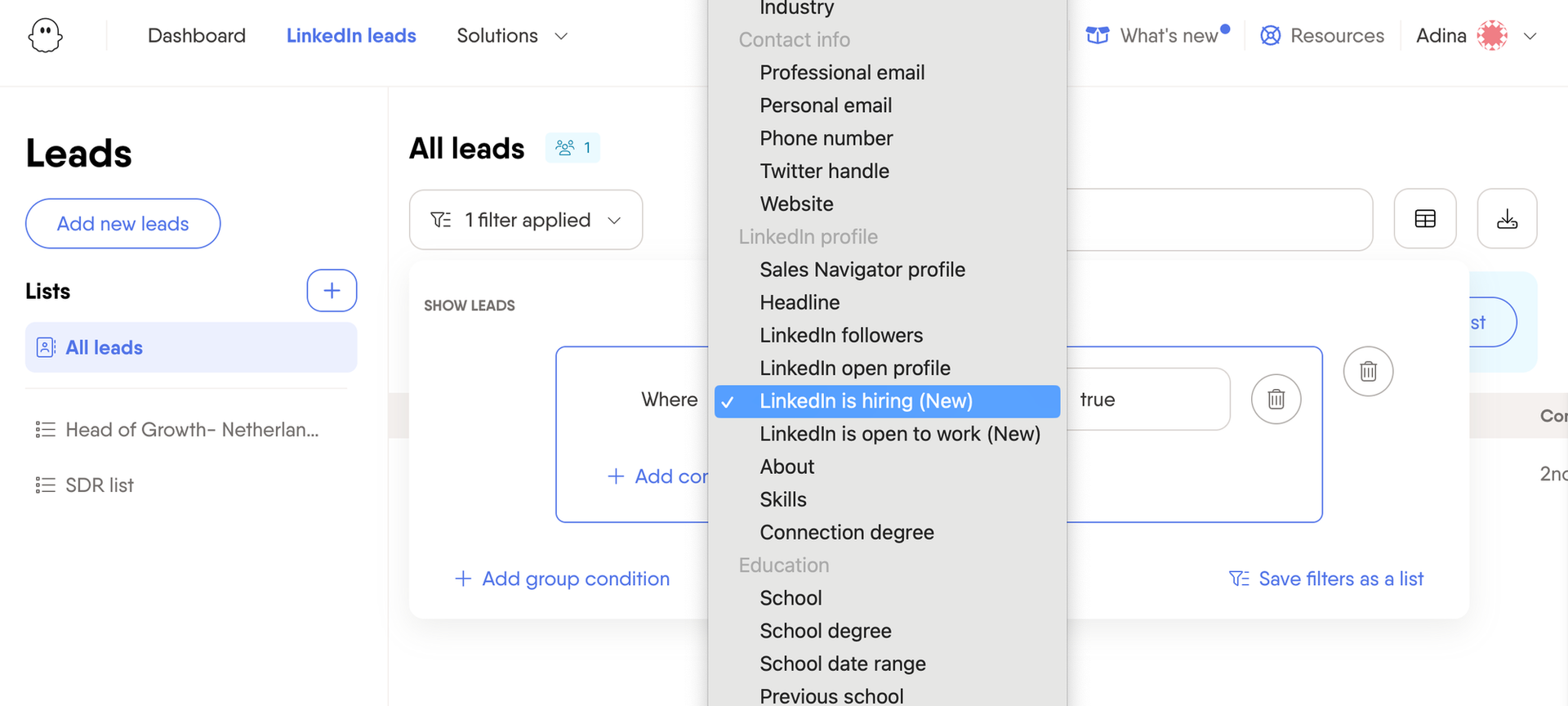A Boolean search is a combination of operators and keywords that can take your regular search on LinkedIn to one with highly specific results.
Whether you use this network to find a job, recruit candidates, or find sales leads through Sales Navigator, knowing how to use LinkedIn boolean search can be a powerful addition to your skill set.
TL;DR
-
You can do a Boolean search on LinkedIn with five different types of operators: quoted searches, parenthetical searches, OR, AND, and NOT operators.
-
The order of precedence in search: quotes, parentheses, NOT, AND, OR.
-
You can use both Boolean search and LinkedIn filters, but the former will give you more precise results.
-
The filter properties that support Boolean search operators are first name, last name, job title, company, and school.
-
You can use Boolean search operators for outreach, complex search results, hiring, and more.
-
To create complex search strings in Boolean, write down certain keywords you want to target, then come up with variations.
-
Use LinkedIn Boolean search to narrow down specific lead lists, then try an automation tool to scrape the data and automate outreach.
Can you do a Boolean search on LinkedIn?
Yes, you can do a Boolean search on LinkedIn by combining keywords and Boolean operators such as AND, NOT, OR.
Types of Boolean search operators available on LinkedIn
Here are LinkedIn's available Boolean search operators and what they can be used for:
-
Quoted searches – for exact phrase searches that include more than one term. For E.g., "software engineer" as a search term will give you just the results with these specific keywords while leaving out related searches like software developer.
-
NOT searches – to exclude a specific keyword from your search. E.g., product manager, NOT marketing, to exclude product marketing managers.
-
OR searches – to get search results that include two or more additional terms instead of just one. E.g. customer care specialist OR customer support specialist.
-
AND searches – to get search results including all of your desired keywords. If one keyword is missing, the result will not be shown. E.g., content marketing specialist AND content marketing manager. The OR, AND, and NOT operators must always be written in capital letters.
-
Parenthetical searches – to do complex searches with Boolean logic and combine multiple operators in one Boolean string. E.g. (sales AND (manager OR director OR "account executive" OR "business development")) AND (("software" OR "technology" OR "SaaS") OR ("B2B" OR "enterprise solutions"))
What is the order of precedence in LinkedIn Boolean searches?
The order of precedence is the order in which LinkedIn "reads" Boolean search operators. It goes like this:
-
Quotes [""]
-
Parentheses [()]
-
NOT
-
AND
-
OR
LinkedIn Boolean search vs LinkedIn filters
LinkedIn's search engine supports both filters and Boolean search strings. You may be wondering which method delivers better search results.
Using filters helps you narrow your search results by basic criteria, such as job title, industry, and location. LinkedIn search filters are okay if you're looking for a more basic list.
On the other hand, using LinkedIn Boolean search helps you run very specific queries.
For example, you can search for an exact phrase with quotation marks, exclude a search term, and more.
Which LinkedIn filters support Boolean search operators?
You can combine a Boolean query with LinkedIn's search filters to get highly targeted results.
Simply use the LinkedIn search bar to get started, and type your Boolean search string using the following properties:
-
First name
-
Last name
-
Job title(s)
-
Company
-
School

You can do the same in LinkedIn Sales Navigator but with a bit more flexibility. You can use Boolean search operators:
-
Search entire profile
-
Find profiles with specific job title
-
Find specific company profiles

When should you use a Boolean search on LinkedIn?
Mastering LinkedIn boolean search is a smart idea for some of the following use cases:
-
Outreach: allows sales teams to filter the most relevant search results with Boolean strings and maximize their chances of closing a deal.
-
Getting complex search results with multiple terms, e.g., searching in a job description with keyword filters.
-
Recruiting: finding job seekers in a specific industry and filtering by title, company, school, and other key phrases.
How to create complex Boolean search strings
To use LinkedIn Boolean search effectively, start with a blank document or a sheet of paper.
Write down a list of the following:
-
Job titles to include (e.g., marketing manager)
-
Job titles to exclude (e.g., performance marketing manager)
-
Company names to include (competitors, companies in the same industry, etc.)
-
Company names to exclude (your own company or those that will not bring relevant search results)
-
General keywords to exclude
-
General keywords to include
You now have a starting list of terms, but you can take it one step further.
Start creating variations of keywords, and you can start playing with search filters to see what provides the best LinkedIn search results.
LinkedIn Boolean search string examples
Looking to get the most out of LinkedIn's search engine? Here are some Boolean string examples for different use cases.
Example #1: (industry) AND (job title)
Using a Boolean search string such as software AND chief technology officer is a great starting point to find leads if you're selling SaaS tools.
With this Boolean operator combination, you can find specific job titles in a relevant industry to get better leads.
Boolean search example: software AND chief technology officer
Example #2: (specific skill) NOT (other skill)
For example: customer success NOT customer service. The two key phrases seem similar but this search string gives you lists of leads with just the first skill set.
Boolean search example: customer success NOT customer service
Example #3: (specific company) AND (specific job title)
Boolean search example: Microsoft AND senior engineer.
Combine keywords in this way to find relevant stakeholders in a target company more easily.
Example #4: title OR title OR title
When you don't want to include all the keywords related to a term but just a handful of the most relevant ones.
Boolean search example: "chief executive officer" OR "CEO" OR "chief operating officer" OR "COO" OR "chief financial officer" OR "CFO" OR "president" OR "vice president" OR "VP" OR "executive director".
This lets you find executive-level roles with more accuracy.
Example #5: Title AND (title OR title) NOT title
If you're in pharmaceuticals and looking to sell to clinicians, this is a good string:
Boolean search example: (title:"physician" AND ("medical director" OR "chief medical officer") NOT "resident")
This lets you target only the stakeholders with purchasing decisions while you exclude keywords designating low-importance titles.
Example #6: (Seniority OR Seniority OR Seniority) AND (Title OR Title) NOT (Seniority OR Title OR KeywordsYouWishToExclude)
Check out this search string:
Boolean search example: ("senior" OR "executive" OR "director") AND ("logistics manager" OR "supply chain manager") NOT ("entry" OR "logistics coordinator" OR "intern")
If you're in the logistics industry, this lets you target only professionals with a certain seniority level while excluding specific seniority levels and roles.
Example #7: (field of work) AND (keyword OR keyword OR keyword) NOT keyword
Here is an example you can learn from:
Boolean search example: ("education") AND ("curriculum development" OR "educational technology" OR "instructional design") NOT "administration"
With this string, you target professionals from the education industry with specialization in curriculum development or edtech, while excluding administration.
Example #8: seniority AND (title OR title) AND keyword NOT keyword
Let's look at this example:
Boolean search example: ("senior" OR "executive") AND ("supply chain manager" OR "logistics director") AND "inventory management" NOT "procurement"
This string helps you find people with a certain seniority level, with different titles and one keyword, but excluding another keyword you don't want to target.
In this case, inventory management is your goal, while you want to avoid getting leads from the procurement sector.
Example #9: seniority AND (title OR title) AND (Keyword OR keywordSynonym)
Say that you're looking for leads from the automotive industry. Consider this use of Boolean operators:
Boolean search example: ("senior" OR "executive") AND ("automotive engineer" OR "manufacturing manager") AND ("vehicle design" OR "automobile production")
It's just as it sounds.
You target leads with a certain seniority level, title, keyword, and synonym, helping you cast a wider net when searching while still remaining precise.
Example #10: (keyword OR keyword) AND (keyword OR keyword) AND..
Boolean search example: (hubspot OR salesforce) AND (asana OR jira).
This lets you target businesses and people interested in tools that are complementary to yours.
With the right combination of search terms, you can find ideal profiles of sales leads looking for a product like yours.
What to do with your targeted Boolean searches
Once your Boolean search on LinkedIn is complete, you can use it greatly. We'll show you how step by step.
-
Save your Boolean search results.
-
Export your list of leads. You will need a LinkedIn scraper for this part of the job. You can export lead lists from LinkedIn Sales Navigator too, but you are going to need a scraper for this as well.
-
Enrich your lead list with AI. With the search process done, you have a list with some fields in it, but the right tool can use AI to enrich those lists with the missing fields. For example, you may know that someone is a software developer, but you'll want to get additional info on the technologies they're familiar with.
-
Build specific lists for outreach. For example, you can filter your list based on people who are hiring. You can't do this directly in Sales Navigator, but you can once you've scrapped the data.

With this knowledge, you can get better search results and personalize your outreach to a greater extent when reaching out with automated LinkedIn messages.
Conclusion
Using Boolean search terms is a must for anyone who wants to get the most out of LinkedIn. It's a great starting point for getting more accurate results and finding the exact LinkedIn users you need.
But don't stop with the list of leads. Once you have LinkedIn profiles that are excellent sales leads, use PhantomBuster to enrich that data and automate your outreach.
